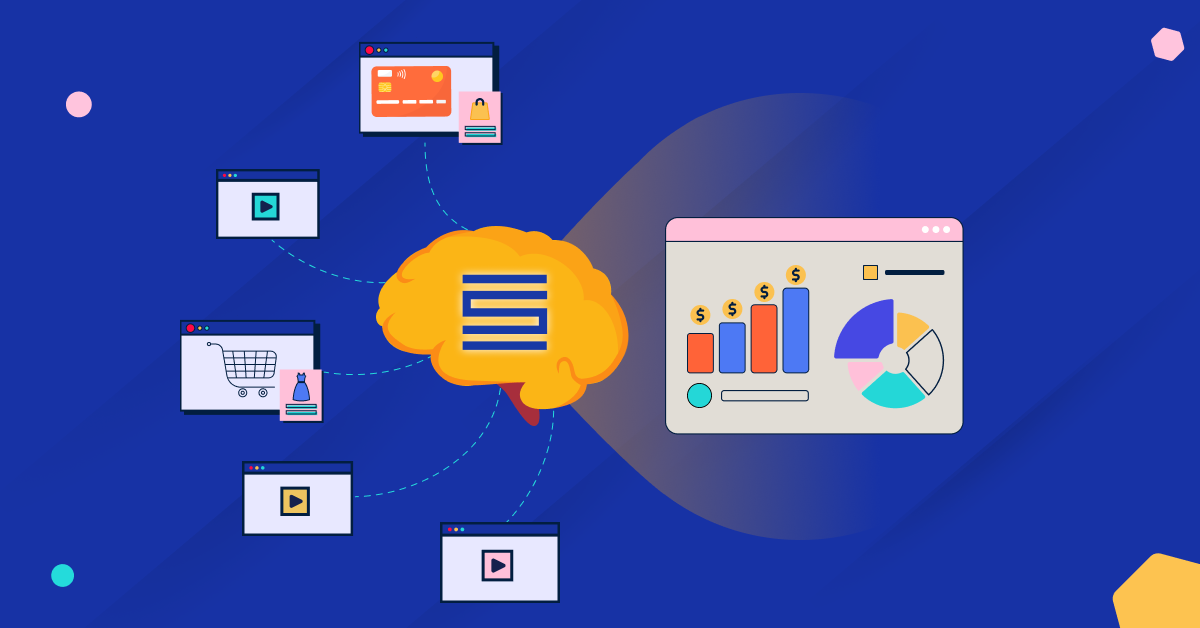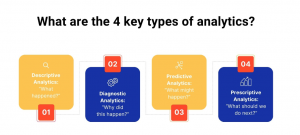How to Leverage AI for Predictive Analytics for eCommerce

As the digital marketplace evolves rapidly, predictive analytics in e-commerce is becoming increasingly vital. With AI’s power, businesses can revolutionize their e-commerce growth in multiple ways. This transformative technology not only aids in data analysis but also elevates customer engagement and personalization to new heights, empowering businesses to navigate the digital landscape with confidence and capability.
Indeed, predictive analytics is a game-changer in the e-commerce industry. It empowers businesses to understand and predict customer behavior and preferences, fundamentally altering customer interactions. It’s not merely a tool; it’s a strategic approach that has the potential to reshape e-commerce globally by creating more personalized and engaging shopping experiences.
Let’s learn more about predictive analytics and its impact on eCommerce.
What is Predictive Analytics in eCommerce?
Predictive analytics in e-commerce involves harnessing historical and current data and sophisticated algorithms to predict customer behaviors and future trends. This process empowers businesses to previse customer needs, enhance supply chain operations, and make informed decisions, eliminating the need for guesswork and ensuring a more efficient and effective business operation.
Remember, predictive analytics is just one facet of data analytics in e-commerce. Unlike descriptive analytics, which focuses on past data, and diagnostic analytics, which aims to understand why certain events occurred, predictive analytics uses current and historical data to forecast future trends and behaviors.

With prescriptive analytics, which provides recommendations on optimizing business operations, these types transcend basic data analytics, offering ecommerce businesses a tangible competitive edge. They enable companies to deliver exceptional service and drive sustainable revenue growth by providing insights, recommendations, and solutions based on past and current data. This competitive edge should inspire businesses to embrace predictive analytics and unlock its full potential.
The Impact of AI-Powered Predictive Analytics on eCommerce
Predictive analytics is making a significant impact on ecommerce in the following three ways:
1. More Personalization
One of predictive analytics’ key benefits in e-commerce is its ability to enhance the customer experience. For instance, when showing a product description to a potential shopper, the product information can be adjusted to match their understanding of language and culture, offering a more personalized and engaging shopping experience. Many online retailers use this information to adapt prices and offer a more competitive experience for individual shoppers.
“Thanks to advanced AI and faster data analysis, personalized recommendations have become more accurate, said Mariano Rodriguez, Founder of LawRank. “By examining customers’ past searches, purchases, demographics, and current activity, companies can now deliver tailored content to individual shoppers.”
In the past year, when people searched for products online, they could find items that matched their preferences using images and search. But now, with intense competition and fast shopping, people have short attention spans. Retailers can now show the exact products that shoppers want to buy at the top of the search results.
2. Improved Access to Real-Time Data
Many companies use predictive analytics to forecast trends, manage budgets, and identify fraud. Advertising platforms have tools that help brands use advanced predictive models to target consumers more effectively. The availability of real-time data has made it easier than ever for brands to take advantage of predictive analytics.
By offering this technology directly within the advertising platform, Google and other advertisers have made strides in creating a fairer competition between large and small brands, focusing on improving customer experience. Although more prominent brands will still spend more and dominate the market, smaller brands can use these tools to work more efficiently, expand their campaigns, and grow their businesses.
Chris Masanto, the CEO and co-founder of PetLab Co., says, “We faced the challenge of accurately forecasting demand and managing inventory in the fast-paced e-commerce environment. This problem often led to either overstocking or stockouts, directly impacting our customer satisfaction. By integrating AI-powered predictive analytics, we gained real-time access to data, allowing us to monitor trends and make informed decisions instantly. This technology enabled us to optimize inventory levels and tailor our marketing strategies to market conditions. As a result, we can ensure our products are always available when customers need them, significantly improving our operational efficiency and enhancing the overall customer experience.”
3. Learn More About Customers
Personalization should be one of many focuses. Instead, it should be an opportunity to understand your customers better. You can place specific individuals into corresponding segments by tracking clicks and storing that information in the CDP. That allows for tailoring a more personalized experience for future shoppers.
“By using customer feedback from sources like reviews, comments, and social media, e-commerce businesses can better understand the overall customer experience,” said Triumph Curiel, Founding Partner at Curiel & Runion. “Analyzing recurring themes, sentiment, and specific feedback provides companies with insights to identify pain points, bottlenecks, and areas of friction in the customer journey.”
Using these insights, online shopping websites can focus on essential areas such as the checkout process, menu navigation, and procedures for refunds or cancellations. Improving these areas can enhance customer experience, customer satisfaction, and retention and build long-lasting loyalty.
How to Use AI for Predictive Analytics in eCommerce Market
Customer behavior is hard to predict. No one can do it alone. With the help of machine learning and artificial intelligence, you can calculate and predict how many users will take action. Here are some ways to use AI for predictive analytics in eCommerce:
1. Identify Cross-Sell and Upsell Opportunities
Businesses can use AI to dig deeper into customer data and preferences, find sales growth opportunities, and plan for better business results. AI is great at analyzing large amounts of customer data to find trends, patterns, and connections that would be hard for humans to spot. These findings help identify potential opportunities to sell more to existing customers.
AI can analyze a customer’s buying history, social media activity, and browsing behavior to predict which products the customer might be interested in following. For example, if customers regularly buy premium workout clothes, the AI can guess they might like new athleisure collections.
Predictive models use past data to predict future behavior, which helps e-commerce businesses plan. An AI tool can study a customer’s behavior and determine the best time to send an email suggesting another product related to their most recent purchase.
Moreover, AI can use predictions to adjust prices in real-time and attract customers by offering discounts on certain products. That can increase sales, customer satisfaction, and faster e-commerce growth.
2. Predict Potential Consumer Win-Back Opportunities
E-commerce companies can now use AI to predict consumer behavior and identify potential customers likely to re-engage. That helps businesses tailor their marketing strategy effectively and forecast potential customer win-back opportunities.
AI uses past customer interactions to predict who is likely to come back. For instance, customers who used to be active but have not been lately might be interested in your products or services. AI looks at lots of data, like how often people buy, what they look at online, and how they’ve responded to past marketing. That helps AI figure out who is likely to start engaging again.
Businesses can create targeted win-back campaigns using AI data insights. AI can help determine the best timing, product selection, and messaging for these campaigns, making them more effective. This personalized approach significantly improves the likelihood of reconnecting with lost customers and driving e-commerce growth.
3. Personalize the Customer Experience
Using AI to create highly personalized shopping experiences is expected to be a significant trend in the upcoming years. AI-driven predictive analytics can help businesses customize their offerings and interactions for individual customers, leading to higher customer satisfaction and increased sales. AI’s use in e-commerce can significantly shape online retail’s future.
According to Segment, 71% of online shoppers would be frustrated by an impersonal shopping experience. E-commerce businesses must utilize predictive analytics to provide valuable suggestions for bundling products together to improve returns.
“It’s essential to ensure that every visitor to your online store has a positive experience, regardless of whether they make a purchase,” said Adam Zayed, Founder of Zayed Law Offices. “That can involve improving the customer journey, introducing loyalty programs, and actively asking for feedback to enhance the shopping experience and encourage return visits.”
Find customers who might stop shopping with you and use special plans to keep them happy. That helps online stores keep customers for a long time, prevent them from leaving, and maximize their spending.

With the help of AI-driven predictive analytics, businesses can create personalized content, like emails suggesting related products or giving discounts on things customers are interested in. This unique marketing can improve the customer’s shopping experience and make them feel important to the business, helping the company grow.
4. Optimize Pricing Predictions
AI predictive analytics can help you predict what customers will do in the future. It can also help you figure out the best price for your products. That is important for selling things. It can be hard to do this on your own, especially when there are many things to consider. AI predictive analytics looks at who is buying your products, what they’ve bought before, and what other companies charge. That can help you sell more and make your customers happy.
Dynamic pricing can be complicated, considering factors like changing demand and promotions. However, historical data and predictive analytics can simplify the process by helping e-commerce managers predict market conditions and set fair prices in real time.
5. Optimize Inventory Levels
AI can help e-commerce businesses manage their inventory more effectively. AI algorithms can predict product demand by analyzing past data and current trends.
Predictive analytics can optimize inventory levels by anticipating future demand, lessening stockouts, and shortening excessive stock. That can lead to better stock management, optimized use of warehouse space, faster order fulfillment, improved cash flow utilization, and a reduction in “out-of-stock” situations.
6. Detect Potential Fraud
AI can improve security in e-commerce businesses by detecting fraudulent activities and unusual behavior, thereby protecting the company and its customers. The retail sector, especially online payment systems, is particularly susceptible to fraud and untaken orders.
Using historical data to predict customer behavior is very helpful in preventing fraud, securing online retail, reducing credit card payment failures, and increasing sales. For example, an AI system can quickly detect if multiple transactions are being made from the same account, which may indicate fraudulent activity. This proactive approach helps build customer trust, provides a safer shopping environment, and saves businesses from significant financial losses.
Conclusion
Recent advancements in AI and machine learning are fundamentally transforming predictive analytics in ecommerce. Every e-commerce store has a valuable opportunity to leverage predictive analytics in its overall strategy.
As AI advances and generative AI becomes more widespread, ecommerce firms can enhance their capabilities, gaining deeper insights and realizing substantial benefits from predictive analytics. That presents an exciting prospect for continuous innovation, driving the ecommerce industry toward remarkable growth and success.
